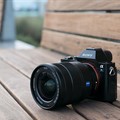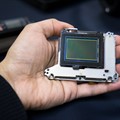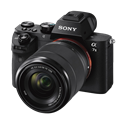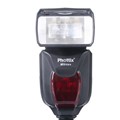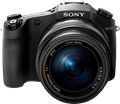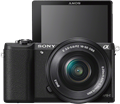Sony announced three new FE primes yesterday, including a 28 f/2, a 35mm f/1.4 and a 90mm f/2.8 macro. We got our hands on the Zeiss Distagon T* FE 35mm f/1.4 and shot with it around Seattle. It features a 9-blade circular aperture and a Direct Drive SSM focus system. Check out our samples gallery
Stories tagged with sony
Three full-frame prime lenses on Sony's lens roadmap officially arrived today which, including the 24-240, brings the total number of FE lenses to eleven. The least expensive of the trio is the 28mm F2 lens, which also supports ultra-wide and fisheye adapters. Next is the long-awaited Zeiss 35mm F1.4 ZA, which is Sony's fastest FE lens to date. Close-up shooters will be interested in the new 90mm F2.8 Macro G OSS lens, which uses a Direct Drive SSM mechanism for ultra-precise focusing. More details here.
Another full-frame lens from Sony's roadmap that hit the market today is a consumer-friendly super zoom. This 24-240mm F3.5-6.3 FE lens features optical image stabilization, five aspherical elements and one ED element, and is sealed against dust and moisture. The lens will ship this month for around $1000.
Sony is releasing a pair of firmware updates this month that will reduce startup times when FE lenses are attached to both full-frame and APS-C bodies. The first update, available now, will make your E-mount camera get ready to shoot in less time when using five currently available FE lenses. The second update, due later this month, will do the same for Sony's a7 series, this time for the four new lenses announced today. Read more
Sony has officially announced four new conversion lenses - two for full-frame and two for APS-C - that can be screwed onto a select group of lenses. On the full-frame side there are ultra-wide and fisheye adapters for the new FE 28mm F2, which drop the focal range to 21mm and 16mm, respectively. The adapters for APS-C lenses - the 20mm F2.8 and 16mm F2.8 specifically - and reduce the focal lengths by 0.75X for the ultra-wide adapter and 0.6X for the fisheye. More details.
The Sony Alpha 7S is a full-frame interchangeable lens camera sporting a 12.2MP CMOS sensor. It is identical in body design to the Sony a7 and Sony a7R, but don't let that fool you. Unlike the other two, the a7S is specially geared toward video and low-light shooters. It's capable of 1080/60p video with full-sensor readout and can turn out uncompressed 4K footage to an external recorder over HDMI. Read review
Sony has announced that it will be branching off its audio and video departments into a separate subsidiary. Sony previously spun off its VAIO PC business one year ago, and the creation of new departments aims to make the company into a profitable entity. Read more
Chris Burkard is a well-established adventure and surf photographer. His landscapes and cold weather surf photos have earned worldwide attention and plenty of high-profile clients. Chris joined us recently in California to take Sony's a6000 for a spin to try out its hybrid AF system on - what else? - sun, sand and surf. See how the a6000 keeps up in our latest real-world test. See video
We swung by the Sony booth at CP+ 2015 in Yokohama, Japan, where they had displays of the latest technologies in their cameras and lenses, as well as an elaborate diorama of a bird in flight over a fabricated landscape, amongst other things. We even sat down with a couple of engineers at Sony to talk about the Alpha 7 lineup. Check out some of the interesting things we learned during our time here with Sony
At the Consumer Electronics show in Las Vegas last month, we got our hands on some mockups of Sony's upcoming FE-mount lenses. Originally promised to start shipping this month, Sony has yet to announce final pricing and availability but it is showing working pre-production samples of the lenses at CP+ in Yokohama, Japan. We're there, and we wasted no time getting our hands on the new lenses - now complete with glass inside them, which is welcome change from the last time we saw them. Click through to see for yourselves
UPDATED: Our initial samples gallery from the Sony a7 II saw the camera tested in a variety of real-world conditions, and now we've followed it up with even more samples from the mirrorless full-frame camera. Better yet, we tested it out in what is arguably one of the most photogenic places on Earth. And while it's nothing compared to actually taking a Hawaiian vacation, browsing through these samples is at least a small reprieve from the winter blues. See gallery
Sony is showing mockups of four new lenses for its full frame FE series for the Alpha 7 on its stand at CES, as well as two wide angle converters. With only six FE lenses to choose from at the moment, Alpha 7 users will be pleased to see some physical evidence of these lenses that Sony initially announced on a roadmap at the Photokina show in September. Scheduled to ship this spring, click through for a closer look at the upcoming lenses
Announced in late November, the Sony Alpha 7 II has received its first firmware update. Somewhat thin on specifics, firmware version 1.10 promises improved image stabilization. The firmware details cite improvements in IS when half-pressing the shutter, in 'Focus Magnifier' mode, during movie recording, and with 'other functions'. Read more
With start of a new year, many photographers will take up a '365 challenge', creating and sharing a photo every day of the year. If you're looking for inspiration to start your own, Toni Ahvenainen's 'Year of the Alpha' project is the perfect place to start. He's a DPR reader, an enthusiast photographer and, of course, a Sony shooter. In our Q&A he tells us how the project started, how it evolved and what he learned along the way. See gallery
Sony has released a firmware update for the SLT-a77 II, its 24MP semi-pro APS-C camera. Firmware 2.00 claims improved autofocus speed in all light conditions, but notably a 2.5x improvement in low light. Support for XAVC-S full HD video recording is also added. Read more
The World Photography Organization has announced its judges for the 2015 Sony World Photography Awards. Photo editors from major publications around the world make up the judging committee. The competition is open to youth, amateurs and pros alike and is accepting entries until early January. The organization has also released a selection of standout submissions. Read more
A production-ready Sony Alpha 7 II just landed in our office and we wasted no time getting together some real-world samples. Sony's follow-up to the a7 comes with a 24MP full-frame CMOS sensor with 5-axis sensor-shift image stabilization. Its Hybrid AF system claims to be 30% faster and 1.5x better at tracking compared to its predecessor, and boasts a number of design refinements. See gallery
Sony announced the Alpha 7 II last week relatively quietly, introducing a new member to its full-frame mirrorless family. The a7 II brings 5-axis in-body stabilization to a full-frame camera for the first time, claiming 4.5 stops in shake reduction. Other updates include improved ergonomics - you can see these for yourself in our hands-on overview of the a7 II. Here's what you need to know about Sony's newest Alpha camera. Read more
Sony Electronics has announced US pricing and availability for its recently announced Alpha 7 II camera. The a7 II is the world's first full-frame mirrorless camera with in-body image stabilization (5-axis, no less), and also offers improved controls, focusing performance, and video specs. It will be available on December 9th for $1700 body only and $2000 with the 28-70mm F3.5-5.6 FE lens. We'll be getting our hands on a beta version shortly and will post samples as soon as possible. Read more
Among all of the excitement around the a7 II, Sony quietly announced a new A-mount lens last week. The 70-300mm F4.5 – F5.6 G SSM II lens for A-mount offers faster AF tracking, a new Nano AR coating, and weatherproofing, and will be available in February for $1150. The company also announced the development of Vario-Sonnar T* 24-70mm F2.8 ZA SSM II and 16-35mm F2.8 ZA SSM II A-mount lenses, which will arrive next Spring with similar improvements. Read more
Sony has announced its Alpha 7 II, which the company has managed to keep very close to its vest. The big story on this 24MP full-frame mirrorless is its 5-axis sensor-shift image stabilization - the first that we've seen in a full-frame camera. Sony claims that this IS system can reduce shake by 4.5 stops using the CIPA standard. The Hybrid AF system has also been improved upon, offering 30% faster speeds and a 1.5X improvement in tracking. The a7 II also sports a larger grip, new front dial, and sensibly relocated shutter release. Read more
Sony has unveiled a new stacked CMOS image sensor for use in smartphones. Called the IMX230, it features 21 effective megapixels, on-chip phase detection AF and 4K video recording. The chip is a 1/2.4-inch type with square pixels measuring 1.12um x 1.12um each. Video of up to 4K (4096 x 2160) resolution is available with HDR function (also available in stills mode). Read more
Phottix has unveiled Sony versions of its Mitros and Mitros+ TTL flash units for that manufacturer's multi-interface hotshoe. The Mitros+ offers remote radio flash control, with built in Phottix Odin and Strato II receivers. Both flash units provide a guide number of 58, with 180° rotation and tilt by 97°. Learn more
*Updated* It appears that Hasselblad has closed its Treviso design center in northern Italy. The facility was responsible for Hasselblad's Lunar, Stellar and HV cameras, all re-badged Sony products aimed at 'amateur photo-enthusiasts who demand the ultimate in both style and performance'. Read more
Sony has launched a 'Pro Support' program with the aim of offering professional photographers the levels of support available from the big DSLR makers. The move presumably comes to help persuade pros to consider switching to the company's SLT and mirrorless camera systems. The program, called Sony Imaging PRO Support, provides 'superior support' so that pros can 'ensure their Digital Imaging products are always ready'. Read more
Sony has introduced a new line of XQD format version 2 memory cards, the G Series. As with other XQD cards, the G Series promises fast read and write speeds that are able to match the demanding needs of select cameras, such as the Nikon D4 and D4s. In turn, Nikon has announced that the D4s will support Sony's version 2 XQD cards, with improved write speeds and burst capacities. Read more
Sony has introduced a new CMOS sensor, calling it the highest sensitivity sensor of its kind. Developed for automotive use, the new chip can capture color images in light conditions down to 0.005 lux. The sensor is 1/3-inch type with 1.27 effective megapixels, and supports a Wide Dynamic Range system that uses extended exposure times rather than using multiple exposures. Read more
Sony's NEX and Alpha range of E and FE-mount cameras have a lot going for them, but some users have reported a 'wiggle' in the lensmount, especially when heavier lenses, or third-party optics via adapters are used. Fotodiox thinks it has the answer with its new 'Tough E-Mount' - literally a replacement lensmount for E and FE-mount cameras. With a single metal ring replacing the two (one metal, one plastic) originally attached to the camera, the Tough E-Mount should (according to the manufacturer) eliminate any movement between camera and lens. Click through for more details
We were so busy playing with new Leica cameras and giant telephoto lenses at Photokina that we totally missed Sony's announcement of four upcoming full-frame E-mount lenses. Four FE lenses are coming in the first quarter of 2015, including three primes and one zoom. Sony didn't reveal too much, but you'll still get the idea by reading this
At Photokina last week we sat down with Shigeki Ishizuka, the global head of Sony’s Imaging Business. As well as talking us through Sony's current Alpha strategy, Ishizuka-san also explained why the name 'NEX' was dropped and told us a little about how Sony's sensor business works. Click through for the full interview
It's the second day of the photography industry's biggest tradeshow and we paid a visit to the Sony booth. Hoping to catch a glimpse of the Alpha QX1 'lens-style camera' paired with a gigantic 70-200mm lens, Sony did not disappoint us. We also got our hands on a pair of new lenses. Take a look around Sony's Photokina 2014 stand with us. Read more
Sony has announced the Vario-Tessar T* FE 16-35mm F4 ZA OSS for its E-mount interchangeable lens cameras, as well as the HVL-F32M flash and XLR-K2M XLR audio adaptor kit. The 16-35mm is the fifth full-frame zoom for Sony's Alpha 7 series. Read more
Sony has unveiled another full-frame compatible lens for its E-mount, the FE PZ 28-135mm F4 G OSS. With an emphasis on its capabilities in video production, it offers three separate control rings for zoom, focus and aperture. The lens is dust and moisture-resistant and uses a Super Sonic Wave Motor for fast and quiet autofocus and iris control. Read more
Sony got a lot of attention when it released a pair of cameras which clip onto a smartphone last fall. They're really going to raise a lot of eyebrows now, with their QX1, which features an APS-C sensor and E-mount. Yep, an Alpha on your phone. Take a tour of the QX1 and the superzoom QX30 cameras right here.
Sony has announced the QX1 and QX30, expanding its line of 'lens-style' cameras ready to be paired with a smartphone. The QX1 is an interchangeable lens model, containing a 20MP APS-C sensor and a Sony E-mount for use with lenses designed for Sony's mirrorless interchangeable lens cameras. More like the existing QX10 and QX100, the QX30 is single unit containing a sensor and lens, providing a 20MP 1/2.3"-type sensor and a longer 30x optical zoom. Read more
German optical manufacturer Zeiss has announced a new range of lenses called Loxia, designed for full frame cameras using the Sony E mount – essentially the Sony Alpha 7 series at the moment. The Loxia 2/35 and Loxia 2/50 are based on the company's existing 35mm f/2 Biogon and 50mm f/2 Planar lenses from the ZM range. Read more
The Sony Cyber-shot DSC-RX10 is a video powerhouse, and Sony is now giving it the same XAVC S codec found on its RX100 III and a5100 models via firmware update v.2. This allows for 1080p/60/30/24 and 720p/120 resolutions at a bit rate of 50Mbps. Aside from the new firmware, a SDXC card is the only other thing you'll need to get started. Update: the firmware is now available in the US, as is a Mac version. Find out how to get it.
Our comparative review of the Panasonic GH4 and Sony Alpha 7S started with a look at their designs, handling and video spec. They've set new benchmarks for the sophistication of their video capabilities, but they're both potentially very capable stills cameras as well. That brings us to part two of our review, which adds six pages including analysis of image quality and dynamic range. We've also expanded our look at the video modes on each camera. Read more
Film industry accessory manufacturer Cinoflex was recently tasked with rigging up a new Sony a7S mirrorless camera for use on a Chevrolet commercial. After some testing, the Cinoflex Type SA7S Camera System was created to allow the filmmakers to attach the necessary range of auxiliary equipment needed on a high budget commercial shoot. Read more
As Sony introduces the Alpha a5100 interchangeable lens camera, it officially leaves behind the NEX moniker its mirrorless line originated with. The a5100 picks up where the NEX-5 series leaves off, combining the 24.3 megapixel APS-C CMOS sensor of the a6000 and the more compact footprint of the NEX-5T. The a5100 also inherits many of the a6000's good qualities, including its impressive autofocus system. The a5100 also one-ups its big brother by offering 1080/60p video at 50Mbps. We took a hands-on, preliminary look at the a5100. Read more
The Sony Alpha a5100 is a petite, compact mirrorless interchangeable lens camera with a lot to offer. We've had access to a pre-production sample for a few days, and as well as a full first impressions review we also got hands-on with Sony's latest Alpha. Click through for a tour of the a5100's major features.
Sony has announce its new Alpha a5100 mirrorless camera, which takes the 'guts' from the a6000 and puts it into the compact body inherited from the NEX-5 line. The a5100 offers the same 24.3MP sensor with on-chip phase detection as the a6000, along with a 3" LCD that flips up 180 degrees for taking self-portraits. The a5100 has impressive video features for its price, including support for the XAVC S codec, which allows for 1080/60p/24p recording at 50Mbps.
With our comparative review underway, we've added studio test scene results from both the Panasonic Lumix DMC-GH4 and Sony Alpha 7S to our comparison tool. The 16MP Micro Four Thirds Panasonic GH4 and 12MP full-frame Sony a7S both shoot 4K video, and we spent some time in part one of our review taking a look at those features. Take a look now at the stills capabilities of both of these cameras by comparing them to each other and an ever-growing list of competing models in our studio test scene comparison tool. Read more
Though they come with vastly different sensor sizes and price tags, the Panasonic Lumix GH4 and the Sony Alpha 7S are similar in spirit. They're both meant for video recording as much as they are for stills. To that point, the 12.2MP full frame A7S and 16MP Micro Four Thirds GH4 are both capable of 4K video output and offer extensive video features. Our comparative review takes a detailed look at how these cameras perform in terms of video and stills, as well how they stack up against one another. Read part one
The Sony Cyber-shot DSC-WX220 and W810, which have been available in certain markets for several months, are making their way onto US shores in August and September. The WX220 features an 18.2MP BSI-CMOS sensor, Bionz X processor, 25-250mm equiv. lens, 1080/60p video, and Wi-Fi with NFC. The W810 offers a 20MP CCD, 26-156mm equiv. lens, and 720p video. The cameras are priced at $200 and $100, respectively. Click through for details.
The Sony SLT-A77 II is that company's latest DSLR using translucent mirror technology. With a 24MP CMOS sensor, it has a newly-designed 79-point AF system and offers 12fps continuous shooting with autofocus. That's all very impressive on paper, but what's it like in the real world? We've pulled together a sample gallery and added it to our a77 II First Impressions Review. See gallery
UPDATE: Sony has released an image taken with its curved sensor, and provided more details on what we might expect from its curved sensor technology. We've updated our previous story with this image and details. Read more
Sony has lowered the price of its Cyber-shot DSC-RX10 premium superzoom. The MSRP in the US is now $998, down from $1299, and prices in Europe have dropped as well (though it's unclear if they're official). It's not known if this was a planned price reduction, or a reaction to the Panasonic FZ1000 which is about to hit store shelves at a list price of $899. Read more
When it was introduced last year, the Sony Cyber-shot DSC-RX10 was peerless. It was the first superzoom to offer a 1"-type sensor, much larger than the 1/2.3"-type chips commonly found in that class. It paired that with an impressive F2.8 constant 24-200mm equivalent zoom. Now the Panasonic Lumix DMC-FZ1000 has joined the RX10 in this newly-minted category, boasting almost certainly the same sensor and a 25-400mm equivalent F2.8-4 lens. They line up nicely for a head-to-head comparison - and that's exactly what we've done. Read more
We've just posted our full review of the Sony Cyber-shot DSC-RX100 III. In this third generation compact, Sony offers a 20.1 megapixel BSI CMOS sensor and a couple of important new features - a faster 24-70mm equiv F1.8-2.8 lens and a pop-up EVF with 1.44M dots. With these additions to what was already an impressive camera, does the RX100 III earn our highest recommendation? See for yourself. Read review





